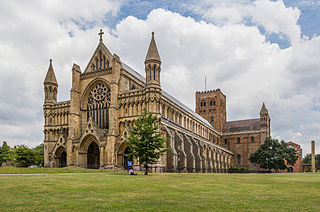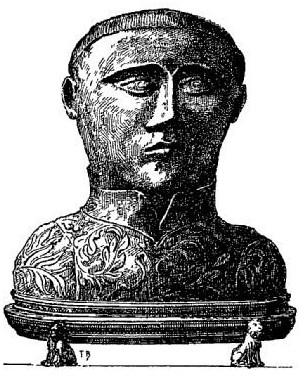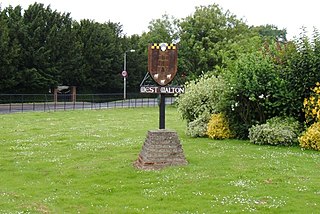
St Albans Cathedral, officially the Cathedral and Abbey Church of St Alban but often referred to locally as "the Abbey", is a Church of England cathedral in St Albans, England. Much of its architecture dates from Norman times. It ceased to be an abbey following its dissolution in the 16th century and became a cathedral in 1877. Although legally a cathedral church, it differs in certain particulars from most other cathedrals in England, being also used as a parish church, of which the dean is rector with the same powers, responsibilities and duties as that of any other parish. At 85 metres long, it has the longest nave of any cathedral in England.

Abbey St Bathans is a parish in the Lammermuir district of Berwickshire, in the eastern part of the Scottish Borders. Unique in its topography, it is situated in a long winding steep wooded valley that follows the Whiteadder Water. The parish had a population of 106 at the 2011 Census.

Beachamwell is a village and civil parish in the Breckland district of Norfolk, England about 5 miles (8.0 km) south west of Swaffham and 10 miles (16 km) east of Downham Market. It has four ancient churches, two of them in ruins. The former parish of Shingham has been annexed.
Wereham is a small village and civil parish in the English county of Norfolk.

Saint Winwaloe was the founder and first abbot of Landévennec Abbey, also known as the Monastery of Winwaloe. It was just south of Brest in Brittany, now part of France.
The Prior of St Andrews was the head of the property and community of Augustinian canons of St Andrews Cathedral Priory, St Andrews, Fife, Scotland. It was established by King David I in 1140 with canons from Nostell Priory, West Yorkshire. It is possible that, initially at least, the prior of St Andrews was subordinate to the bishop as abbot, but by the 13th century the canons of St Andrews were given freedom by the bishop to elect their prior. By the end of the 13th century, the abbacy of the native canons was no longer there to challenge the position of the priory, and the native canons themselves had been formed into a collegiate church.

In the Middle Ages, from the 11th century, the Cluniac order established a number of religious houses in the kingdoms of England and Scotland.

St Mary the Virgin's Church is an active Anglican parish church in Eccles, Greater Manchester, England. The church is in the Eccles deanery, the archdeaconry of Salford and the diocese of Manchester. Together with St Andrew's Eccles, St Paul's, Monton, Christ Church, Patricroft and St James', Hope the church is part of the team benefice of Eccles. The church was granted Grade I Listed status in 1964.

St Michael's Church is in the town of Kirkham, Lancashire, England. The church is recorded in the National Heritage List for England as a designated Grade II* listed building. It is an active Anglican parish church in the diocese of Blackburn, the archdeaconry of Lancaster and the deanery of Kirkham.

All Saints Church is in the small village of Weston-on-Avon, Warwickshire, England. The church is recorded in the National Heritage List for England as a designated Grade I listed building. It is an active Anglican parish church in the diocese of Gloucester, the archdeaconry of Cheltenham and the deanery of Campden. Its benefice is combined with those of St Swithin's, Quinton and St Peter's, Welford.

West Walton is a village and civil parish in the King's Lynn and West Norfolk District of Norfolk, England.

St Michael's Church is a redundant Anglican church in the village of Burwell, Lincolnshire, England. It is recorded in the National Heritage List for England as a designated Grade I listed building, and is under the care of the Churches Conservation Trust. It stands on a hillside by the A16 road as it passes through the village.

St Margaret's Church is a redundant Anglican church in the village of Hales, Norfolk, England. It is recorded in the National Heritage List for England as a designated Grade I listed building, and is under the care of the Churches Conservation Trust. The church stands in open fields to the south of the village and to the east of the A146 road.

St Mary's Church is a redundant Anglican church in the village of East Ruston, Norfolk, England. It is recorded in the National Heritage List for England as a designated Grade II* listed building, and is under the care of the Churches Conservation Trust. The church stands in an isolated position on the east side of the B1159 road, some 2 miles (3 km) north of Stalham. It is noted for its 15th-century painted and carved chancel screen.

St Andrew's Church is a redundant Anglican church in the village of Walpole, Norfolk, England. It is recorded in the National Heritage List for England as a designated Grade I listed building. and is under the care of the Churches Conservation Trust. The church is sited in the north part of the village, known as Walpole St Andrew, 8 miles (13 km) west of King's Lynn, to the south of the A17 road.

A Bresse house is a timber-framed house of post-and-beam construction, that is infilled with adobe bricks and is typical of the Bresse region of eastern France. A large hip roof protects the delicate masonry from rain and snow. The house is almost always oriented in a north–south direction, the roof on the north side often being lower. This configuration offers the optimum protection from the bise, a cold northerly wind typical of the region, which is deflected over the house by the low, sweeping roof on the northern gable end. The living rooms are on the south side, the main façade facing the morning sun. Usually each room has one or two outside doors, so that no space is sacrificed for passages.

The Monastery of Santa María de Aguas Vivas, located in the municipality of Carcaixent (Valencia), Spain, is a religious building dating back to the 13th century.

Kidmore House is a Grade II* listed stately home in the village of Kidmore End, in Oxfordshire, England.

The Church of St Mary the Virgin is the Church of England parish church of Letchworth in Hertfordshire. A church appears to have been on the site since before the Norman Conquest. The current church was built in the late 12th century and is Grade II listed. It comes under the Diocese of St Albans. The original dedication of the church is unknown; it was rededicated to St Mary during the First World War.

Edward Browning was an English architect working in Stamford.



















